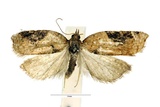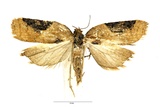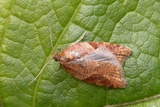Acleris comariana (Lienig & Zeller, 1846) Species
Last modified: Nov. 22, 2025, 1:02 p.m.
The status of this species in Belgium is insufficiently known because of its similarity to Acleris laterana and therefore it is best to check the genitalia. The current distribution (after 2004) is based only on individuals that have been checked for genitalia.
Based on studies of the genitals, this species is much rarer than the more common Acleris laterana.
Details
- Classification
- Family: Tortricidae > Subfamily: Tortricinae > Tribus: Tortricini > Genus: Acleris > Species: Acleris comariana
- Vernacular names
- Okergele driehoekbladroller (NL), Strawberry Tortrix (EN)
- First mention in Belgium
- Dufrane A. 1945b. Peronea comariana Z. en Belgique. — Lambillionea 45: 33–36. On page 33.
- Status
-
Native
Distribution
Imago
Wingspan 13–18 mm. A highly variable species, up to seven forms or aberrations have been described, many of which are identical in appearance to other Acleris species such as Acleris laterana. Wing pattern among the different forms varies considerably, but all have a dark triangular costal patch which ranges in color from brown to red to black.
Form: potentillana - costal blotch blackish, ground colour beige, sub-basal fascia obsolescent. Similar to A.laterana f. comparana.
Form: comparana - costal blotch blackish, ground colour yellow-brown.
Form: fasciana - costal blotch blackish, ground colour whitish-grey coarsely irrorate fuscous and suffused red-brown between costal blotch and dorsum.
Form: latifasciana - costal blotch red-brown, otherwise as f. fasciana. Similar to A.laterana f. laterana.
Form: proteana - costal blotch red-brown, ground colour light grey. Similar to A.laterana f. labeculana.
Form: brunneana - costal blotch red-brown, ground colour red-brown, sub-basal fascia obsolescent.
Form: fuscana - costal blotch poorly defined.
This species fly earlier than Acleris laterana from June to July and is almost invariably smaller in size.
Egg
Eggs are laid on lower parts of the plant, usually on the stipules or petioles.
Bionomics
The larva feeds between spun leaves and in the flowers and pupates in a folded leaf. The species hibernates in the egg stage.
They are active from dusk onwards and later come to light.
Flight periods
The adults fly usually in two generations a year from mid-June and July and again from August till early November.
Observed on
- Host plant (species):
- Geum rivale and Potentilla palustris
- Host plant (genera):
- Fragaria
The larva feeds on a great variety of plants like Potentilla, Salix, Fragaria, Geum and also on glasshouse Azalea's.
Habitat
It prefers wetlands and bogs.



